In February 2000, I stood on the Connemara shore at Ervallagh, looking over at Inishlacken island. The previous Christmas, my friend Mary Hughes had given me the gift of Three Men on an Island by James MacIntyre, a memoir of the summer he spent there in 1951, at the invitation of Gerard Dillon. It was perfect reading material on the slow days between Christmas 1999 and festivities to welcome the new millennium.
As I stood gazing at the island and the sea, a thought came, as if from elsewhere saying, “you must put artists back on the island”.
On that cold and damp winter’s day, the seeds of The Inishlacken Project were planted; it would become an annual gathering of artists.
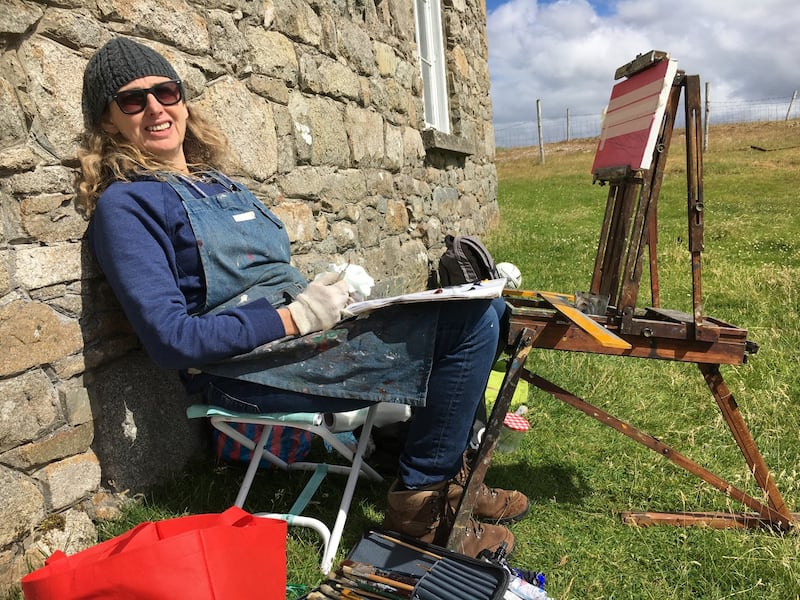
By 1951, Gerard Dillon was already an established figure in Irish art. Originally from Belfast, he had lived in London before eventually settling in Dublin. He was fascinated by the west of Ireland, he had first visited in 1939.The island remained a strong backdrop and narrative in his figurative paintings. MacIntyre, a reluctant apprentice mechanic and a young artist, also from Belfast, had an unexpected financial windfall, which made it possible for him to make his way to Inishlacken and join Dillon. His journey took him via Dublin where he met with the artist George Campbell – the third man.
MacIntyre's book, Three Men on an Island, written 40 years later, tells the stories of the artists at work, sketching and painting and documenting their encounters with the island people, their escapades of going swimming, running out of supplies when weather-bound, and rowing to and from the island, to the nearest mainland village, Roundstone. They were often the victims of run-away geese or toe-biting crabs, and saw sharks swimming alongside their currach.
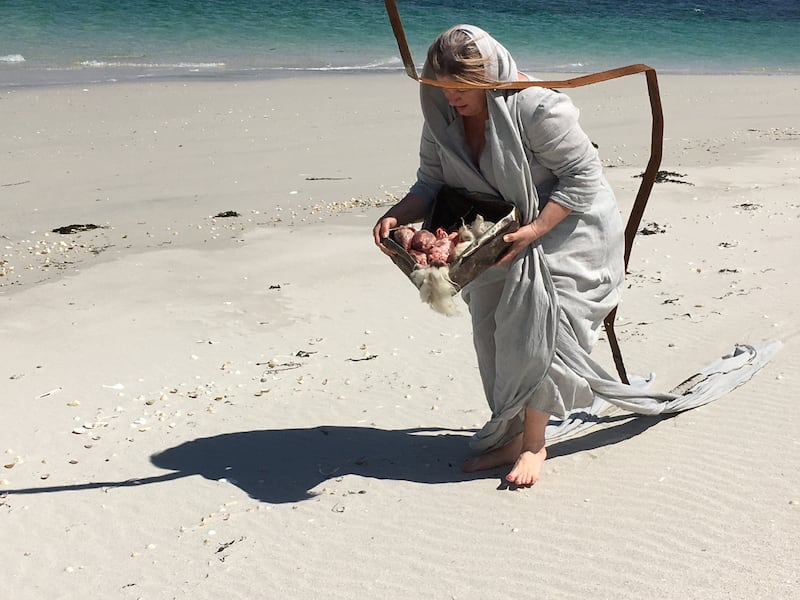
MacIntyre, the quiet man of the group, documented a compelling account, as beautiful and illustrative as his paintings.
He returned to the island in the early 1990s with a film crew. He was struck by how the island community and families were gone, including Gerard and George, who had both died young. He writes, “The island I knew had vanished like a dream...The silence hugged itself close, wrapping memories of that summer around me...Halfway down the harbour steps I stopped to give our cottage and the past a final salute. No it was not a bit like last time.”
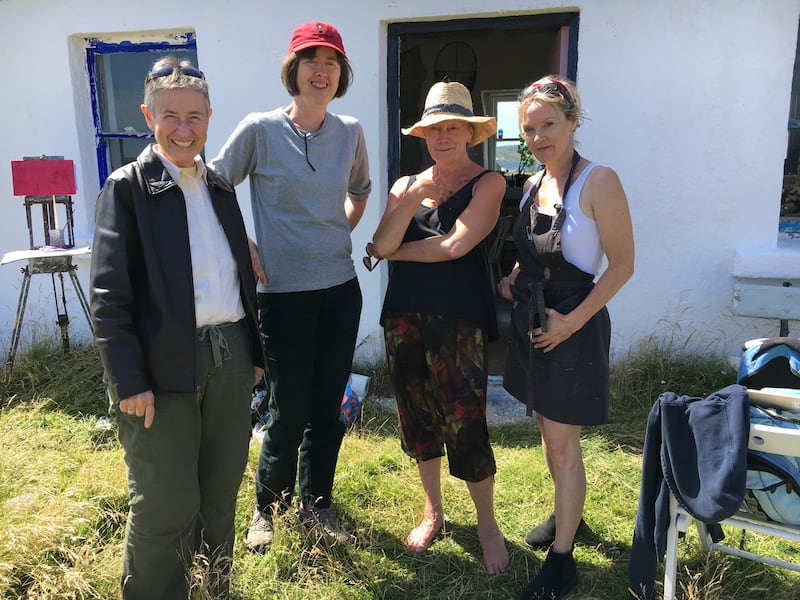
I wondered about the paintings they would have still had in their heads, all the images still waiting to be made. I felt that loss acutely, and a need to make it right. I thought about the description of life on the island, the people who seem so vibrant in the book and how those artists were just part of the everyday to them. Between them, the artists Dillon, MacIntyre and Campbell created a unique archive of 20th century Irish art on Inishlacken in 1951, and now, at the turn of the new century and a new millennium, it was my job to create another.
That February of 2000, I went back to Belfast to prepare for a solo exhibition at the Old Museum Arts Centre. I had also been accepted to attend an artist’s residency at the old and mysterious Errisbeg house in Roundstone, during the annual arts festival. I rented a small apartment in Roundstone, and set off again in September, to see what a winter along the wild coast of Connemara would be like.
My first neighbour in Roundstone was Christina Lowry. We chatted every day on the path between our homes, while she was feeding her cats. Her father had been born on Inishlacken, and her elderly mother remembered all the artists. She had even hosted George and Madge Campbell in their bed and breakfast.
Lowry encouraged me to pursue my idea of putting artists back on the island, and in July 2001 the Inishlacken Project came in to being. At my invitation, a small group of painters and interested parties made a day trip. I started to imagine who I could invite in the future. I am so conscious that the island and the ancestors of the people, the spirit of those families, must be respected. It feels, always, a living space, with its own pulse – and I am not casual about it, nor the cooperation and collaboration of the local people.
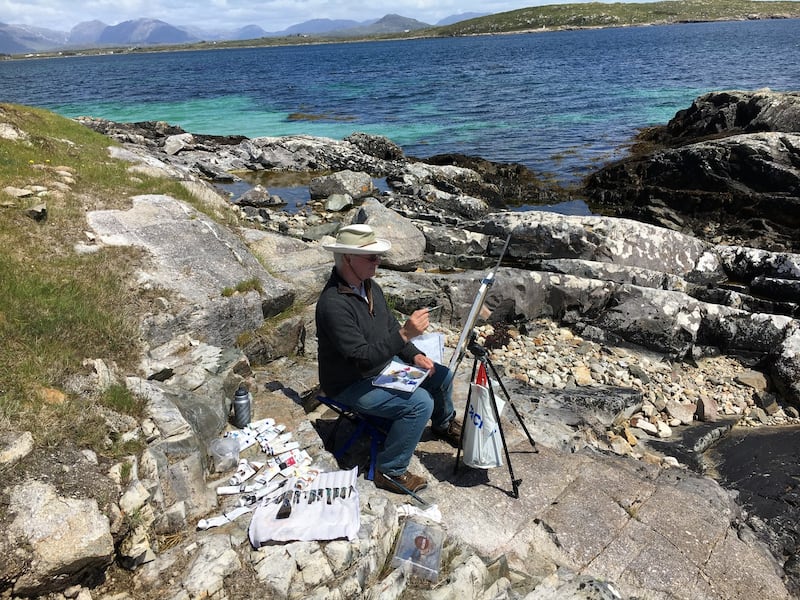
The third week in June is when we now go to the island; the longest days and shortest nights make for optimum work time. The sun never really sets, it only hides behind Errisbeg hill and paints a low streak of red behind the Twelve Bens, erupting in to full daylight at four in the morning. Some artists paint en plein air, some make drawings. We have had a few portrait and life drawing sessions on rainy days when the restored schoolhouse is our refuge.
The support of the Ashe family, owners of the schoolhouse, has made it possible not only to take shelter, but also to stay over for a night or two. St John’s Eve is the most spectacular time to be there, as bonfires light the landscape and we have a 360 degree view of the marking of mid-summer. It is, as one artist called it, “a pause in the year”. Artists also have worked in photography, video, printmaking, performance, installation, sculpture, poetry and prose, in response to Inishlacken.
Since 2001, almost 100 artists have taken part in the annual residency. We have held workshops on the island, and exhibitions in Roundstone, Clifden Arts Festival, Galway Arts Centre, The Linen Hall Library and The Gerard Dillon Gallery, Belfast and the Redhouse Arts Centre in Syracuse, New York. We even exhibited on the island for Culture Night in 2013. The project has also become a focal point for descendants of the island, mostly US-born, who have made the journey and become part of the collective narrative of the new story and life of the island.
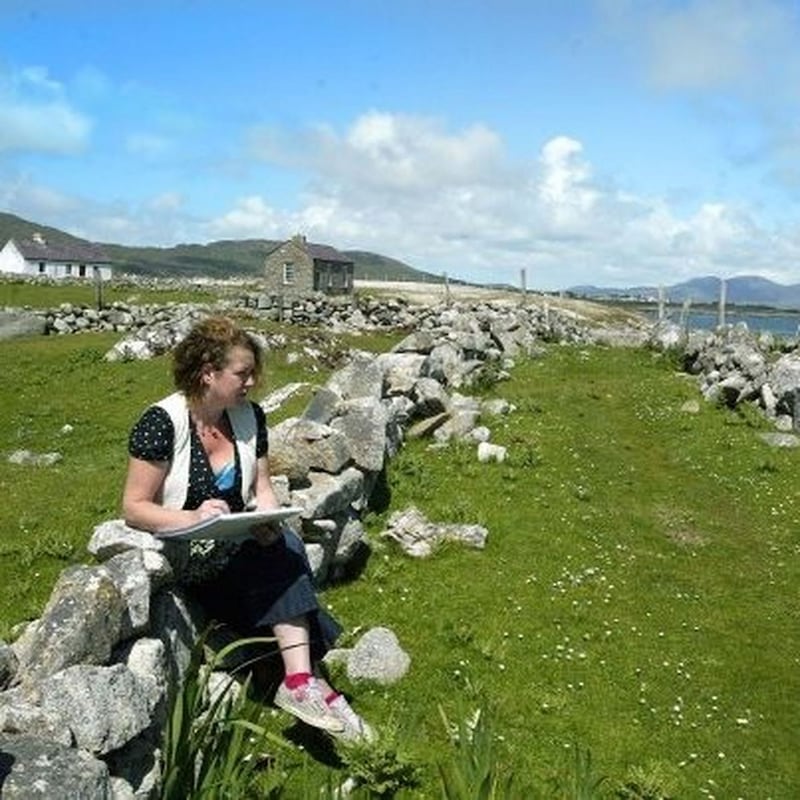
Every January I sit down and draw up a list of artists who I would like to invite to the island, based on the quality of their work. A chance meeting in Roundstone with the UK-based artist Caroline Wright in 2007 has led to a long standing collaboration and friendship. Other meetings happened on residencies I have been on in Australia and Italy, resulting in visits by the Australian composer Kate Moore, and Danish visual artist Charlotte Troldahl.
A vital aspect of the project is maintaining a "cultural corridor" between Northern Ireland, particularly Belfast, and the west, with contributions by poets Maria McManus and Michael Longley, and Belfast-based visual artists including Susan McKeever, Joseph, Catherine and Simon McWilliams, Tony Hill, Denise and Brian Ferran, Annemarie Mullan, Jayne Cherry, Michael Doherty and Colin McGookin.
From south of the border, artists include Una Sealy, James Hanley, Carey Clarke, John Behan, Gavin Lavelle, Mick O’Dea, Jennifer Cunningham, Bernie Dignam, Dorothy Smith, Eamon Coleman, Lia Laimbock and Maeve McCarthy, Éilís ní Dhuibhne, Moya Cannon and Kate Thompson, who writes as Kate Beaufoy. We have also enjoyed the long term support of Roundstone resident Tim Robinson, who dedicated an entire chapter of his 2006 book, Connemara, Listening to the Wind, to a day he spent on the island with us. Mary Hughes’ daughter Susan, an accomplished visual artist, will be taking part in this year’s residency.
One of the veteran returnees to the island is Margaret Irwin West, a 93-year-old printmaker, recently elected to Aosdána. A young New York based artist, Alexis Kandra, is a descendant of an Inishlacken family, and she worked there in 2017. Her cousin, art historian Erin Hinson from Pittsburgh, was the first member of their family to set foot on the island in nearly 100 years, when she documented the 2013 Culture Night exhibition. Barbara Kenny, a teacher and poet living in Canada, has frequently attended the Inishlacken week, and I have used her words as inspiration for paintings. Writer and journalist Nancy Keefe Rhodes makes the visit annually from Syracuse, New York, following another chance meeting, and she is working with me on a major publication to celebrate the 20th anniversary of the Inishlacken Project in 2021. We are also planning a series of exhibitions.
I often ask myself what it is about Inishlacken, Roundstone and the west of Ireland that has drawn the attention of so many artists, particularly from the north. It could not be more different, visually, from the red-bricked city of Belfast, sitting as it does between the Castlereagh and Belfast Hills. I can cast an eye at Belfast artists like Paul Henry, Frank McKelvey, Robert Taylor Carson and Cecil Maguire to note the procession of Ulster painters who have made their mark in the west. The island itself, with its patchwork of fields and skirts of rock and seaweed, must have seemed like paradise to Dillon, Campbell and MacIntyre. It is paradise to me, conjuring constant questions, new ideas and images: to share this is all I can do.
James MacIntyre died in 2015 aged 89; soon after, my friend Mary Hughes also died. Three men on an Island was placed beside her when she was laid out. She never got to visit Inishlacken, but her instinct to give me the book was life-changing, and has resulted in an extraordinary journey and time in my life. It has created a family of artists out of an odd marriage – a Belfast artist searching for ghosts of other artists she never met.
I still don’t know what draws us all here, but I keep looking.
Rosie McGurran lives and works in Roundstone in Connemara. She is a long standing member of the Royal Ulster Academy in Belfast. She will be exhibiting at the ArtisAnn Gallery Belfast in July and August. rosiemcgurran.com
















